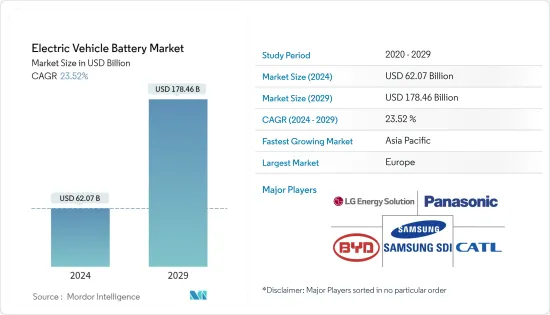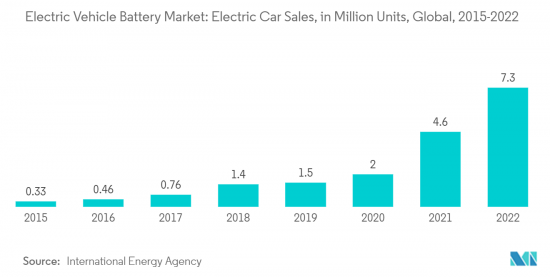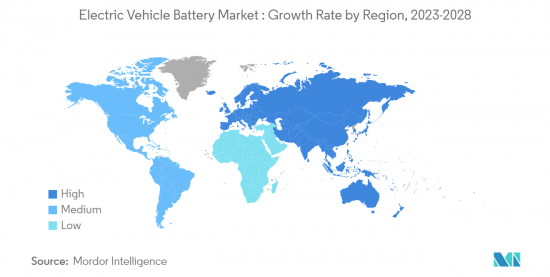 |
市場調査レポート
商品コード
1430026
電気自動車用バッテリー:市場シェア分析、産業動向・統計、成長予測(2024~2029年)Electric Vehicle Battery - Market Share Analysis, Industry Trends & Statistics, Growth Forecasts (2024 - 2029) |
||||||
● お客様のご希望に応じて、既存データの加工や未掲載情報(例:国別セグメント)の追加などの対応が可能です。 詳細はお問い合わせください。
| 電気自動車用バッテリー:市場シェア分析、産業動向・統計、成長予測(2024~2029年) |
|
出版日: 2024年02月15日
発行: Mordor Intelligence
ページ情報: 英文 200 Pages
納期: 2~3営業日
|
- 全表示
- 概要
- 目次
電気自動車用バッテリーの市場規模は2024年に620億7,000万米ドルと推定され、2029年には1,784億6,000万米ドルに達し、予測期間中(2024-2029年)にCAGR 23.52%で成長すると予測されます。

主なハイライト
- 中期的には、リチウムイオン電池価格の下落、電気自動車需要の拡大、電気自動車販売促進のための政府支援政策などの要因が、予測期間中の電気自動車用バッテリー市場の最も重要な促進要因の1つになると予想されます。
- その一方で、重要な原材料の需給ギャップがあります。これは予測期間中、電気自動車用バッテリー市場の脅威となります。
- とはいえ、電気自動車の効率向上と相まって、公共充電インフラ配備のための政府の支援政策と投資は、近い将来、市場の成長に大きな機会を生み出すと予想されます。
- アジア太平洋地域は、中国、インド、日本などの国々からの需要の増加により、電気自動車用バッテリー市場で大きな成長が見込まれています。
EVバッテリー市場動向
市場を独占するリチウムイオン電池
- リチウムイオン電池は電気自動車に搭載される二次電池の一種で、ニッケル・カドミウム二次電池や鉛二次電池に比べてエネルギー密度が高いです。リチウムイオン電池のこれらの特徴により、メーカーは電池パック全体のサイズを小さくしてスペースを節約することができます。リチウムイオン電池は最も軽い金属のひとつです。リチウムイオン電池にはリチウム金属は含まれていませんが、イオンが含まれています。
- リチウムイオンバッテリーは、他のタイプのバッテリーと比べて、主にその有利な容量対重量比のために人気を集めています。リチウムイオン電池の普及を後押しするその他の要因としては、性能の向上(長寿命、低メンテナンス)、保存性の向上、環境への配慮、急速充電などが挙げられます。リチウムイオン電池の価格は通常、他の電池よりも高いですが、競合他社の研究開発活動の活発化により低下し始めています。
- リチウムイオン電池は従来、主に携帯電話やパソコンなどの民生用電子機器に使用されてきましたが、電気自動車がCO2や窒素酸化物などの温室効果ガスを一切排出せず環境負荷が低いなどの理由から、ハイブリッド車や完全な電気自動車(EV)の動力源として使用されるよう設計を見直す動きが加速しています。
- SVOLT energy Technology社は、ドイツ・ザールルイスに欧州初のリチウムイオン電池工場を建設し、2023年末までに生産を開始する予定です。
- 2022年5月、Stellantis N.V.とSamsung SDIは、米国インディアナ州ココモに電気自動車用リチウムイオン電池製造施設を建設すると発表しました。この工場は2025年に稼動予定で、当初の生産能力は23GWh、数年後には33GWhまで拡大することを目指しています。合弁会社はこの製造工場に25億米ドル以上を投資する予定です。
- リチウムイオン電池は他の電池技術よりも安全性が高く、すべての電池メーカーが、電池が故障した際に消費者を保護する安全対策と基準を確保しています。
- 自家用車と商用車の両方の用途で電気自動車を介した新しいエキサイティングな市場の出現は、世界中でリチウムイオン電池の需要を促進すると予測されています。さらに、リチウムイオンバッテリーは、他のバッテリー(すなわちバルブ制御鉛蓄電池)よりもいくつかの利点があり、データセンターでの使用に適しています。
- さらに、乗用車全体に占めるEVの割合および販売台数の増加により、欧州と北米ではリチウムイオン電池の需要が増加しています。さらに、欧州連合(EU)が2019年に開始した「グリーンディール政策」により、EVのシェアは増加し、予測期間中にリチウムイオン電池の需要をさらに押し上げる可能性が高いです。「グリーンディール政策」は、2050年までにカーボンニュートラル目標を達成するため、2030年までに炭素排出量を50%以上削減することを目標としています。
- 電気自動車の販売は世界中で大幅に増加しています。世界の販売台数は、2021年の460万台から2022年には730万台に達しました。電気自動車の販売台数の増加は、リチウムイオン電池の需要増加につながります。
- したがって、上記の点から、リチウムイオン電池は予測期間中に市場を独占すると予想されます。

アジア太平洋地域が著しい成長を遂げる見込み
- アジア太平洋地域が世界市場を独占すると予想されます。中国、日本、インドなどの国々で電気自動車の配備が進み、都市化や電力購入平価の上昇に伴って自動車需要が高まっているため、この地域ではリチウムイオン電池の使用量が大きく伸びると予想されます。
- エネルギー効率基準やピーク電力料金の増加、技術の進歩といった好意的な政策により、商業・産業(C&I)部門では主に中国とインドの力強い成長によって、プロジェクト開発業者からより多くの注目を集めるようになり、これが同地域におけるリチウムイオンベースのエネルギー貯蔵システムの需要を促進すると予想されます。
- 中国は電気自動車の最大市場の1つであり、同国における電気自動車の採用増加はクリーンエネルギー政策に沿ったものです。さらに、中国政府は電気自動車の導入を促進するため、金銭的・非金銭的なインセンティブを提供しています。
- インドでは、リチウムイオン電池は主に電気自動車に使用されています。インドはアジア太平洋地域におけるリチウムイオン電池の主要輸入国であり、2022年4月から11月の間に約5億4,860万個のリチウムイオン電池を輸入し、2021年から2022年の間に約6億1,680万個(18億3,000万米ドル相当)のリチウムイオン電池を輸入しました。
- インド政府は、2030年までに二輪車と三輪車を100%電気自動車に転換し、自動車販売台数の30%をEモビリティに転換することを目標としています。現在、インドはEV用バッテリーの調達を他国に依存しており、その結果、EVの価格が高騰しています。インドの自動車部門にEVが普及すれば、リチウムイオン電池の国産化が促進され、経済的に成り立つようになると予想されます。
- 以上のことから、アジア太平洋地域は予測期間中、EVバッテリー市場の大幅な成長が見込まれます。

EVバッテリー産業概要
電気自動車用バッテリー市場は適度に断片化されています。市場の主要企業(順不同)には、Panasonic Corporation、LG Energy Solution Ltd、Contemporary Amperex Technology、Samsung SDI、BYDなどがあります。
その他の特典:
- エクセル形式の市場予測(ME)シート
- 3ヶ月間のアナリストサポート
目次
第1章 イントロダクション
- 調査範囲
- 市場の定義
- 調査の前提
第2章 エグゼクティブサマリー
第3章 調査手法
第4章 市場概要
- イントロダクション
- 2028年までの市場規模および需要予測(単位:米ドル)
- 政府の規制と政策
- 最近の動向と展開
- 投資機会
- 市場力学
- 促進要因
- リチウムイオン電池価格の下落
- 電気自動車販売促進のための政府の支援政策
- 抑制要因
- 主要原材料の需給ギャップ
- 促進要因
- サプライチェーン分析
- ポーターのファイブフォース分析
- 供給企業の交渉力
- 消費者の交渉力
- 新規参入業者の脅威
- 代替品の脅威
- 競争企業間の敵対関係
第5章 市場セグメンテーション
- 電池タイプ
- 鉛蓄電池
- リチウムイオン電池
- その他の電池タイプ
- 車両タイプ
- バッテリー電気自動車(BEV)
- プラグイン・ハイブリッド車(PHEV)
- ハイブリッド電気自動車(HEV)
- 地域別市場分析(2028年までの市場規模・需要予測(地域別のみ))
- 北米
- 米国
- カナダ
- その他北米
- 欧州
- ドイツ
- フランス
- 英国
- その他欧州
- アジア太平洋
- 中国
- インド
- 日本
- 韓国
- その他アジア太平洋地域
- 南米
- ブラジル
- アルゼンチン
- その他南米
- 中東・アフリカ
- サウジアラビア
- アラブ首長国連邦
- 南アフリカ
- その他中東とアフリカ
- 北米
第6章 競合情勢
- M&A、合弁事業、提携、協定
- 主要企業の戦略
- 市場シェア分析
- 企業プロファイル
- Panasonic Corporation
- LG Energy Solution Ltd
- Contemporary Amperex Technology Co. Ltd
- Samsung SDI Co. Ltd
- BYD Co. Ltd
- Narada Power Source Co. Ltd
- East Penn Manufacturing Company
- GS Yuasa Corporation
- Clarios
- Hitachi Ltd
第7章 市場機会と今後の動向
- 電気自動車の効率化に伴う公共充電インフラ導入投資の増加
The Electric Vehicle Battery Market size is estimated at USD 62.07 billion in 2024, and is expected to reach USD 178.46 billion by 2029, growing at a CAGR of 23.52% during the forecast period (2024-2029).

Key Highlights
- Over the medium term, factors such as declining lithium-ion battery prices, growing demand for electric vehicles and supportive government policies to promote electric vehicle sales, are expected to be one of the most significant drivers for the electric vehicle battery market during the forecast period.
- On the other hand, demand-supply gap of the vital raw materials. This poses a threat to the electric vehicle battery market during the forecast period.
- Nevertheless, supportive government policies and investment for the deployment of the public charging infrastructure clubbed with the increasing efficiency of the electric vehicle are expected to create a significant opportunity for the market's growth in the near future.
- Asia-Pacific is expected to witness a significant growth in the electric vehicle battery market, owing to the increasing demand from countries such as China, India, Japan, and other countries.
EV Battery Market Trends
Lithium-ion Battery to Dominate the Market
- A lithium-ion battery is a type of rechargeable battery installed in electric vehicles and has a higher energy density when compared to nickel-cadmium and lead-acid rechargeable batteries. These features of the lithium-ion batteries will enable the manufacturers to save space by reducing the overall battery pack size. It is one of the lightest metals. Although lithium-ion batteries do not contain any lithium metal, they contain ions.
- Lithium-ion battery is gaining more popularity compared to other battery types, majorly due to its favorable capacity-to-weight ratio. Other factors that contribute towards boosting its adoption include better performance (long life and low maintenance), better shelf life, Environment friendly and fast charging. The price of lithium-ion batteries is usually higher than other batteries but it has started declining due to increase in R&D activities by other competitors.
- Lithium-ion batteries have traditionally been used mainly in consumer electronic devices, such as mobile phones and PCs, but are increasingly being redesigned for use as the power source of choice in hybrid and the complete electric vehicle (EV) range, owing to factors, such as low environmental impact, as EV does not emit any CO2, nitrogen oxides, or any other greenhouse gases.
- SVOLT energy Technology plans to build the first European lithium-ion cell factory in Saarlouis, Germany, with production scheduled to begin by the end of 2023.
- In May 2022, Stellantis N.V. and Samsung SDI announced the construction of an electric-vehicle lithium-ion battery manufacturing facility in Kokomo, Indiana, United States. It is anticipated that the plant will be operational in 2025, with an initial capacity of 23 GWh, with an aim to increase to 33 GWh in the next few years. The joint venture company is going to invest over USD 2.5 billion in the manufacturing plant.
- Lithium-ion batteries are more than safer than other battery technologies, and all the battery manufacturers ensure safety measures and standards to protect consumers in case of a battery failure.
- The emergence of new and exciting markets via electric vehicles for both personal and commercial vehicle applications is projected to drive the demand for lithium-ion batteries across the globe. Furthermore, lithium-ion batteries have several merits over other batteries (i.e., valve-regulated lead-acid), which make it preferable to be used in data centers.
- Further, the share of EVs in total passenger cars has been increasing and owing to the increased sales, the demand for lithium-ion batteries in Europe and North America has been increasing. Moreover, with the 'Green Deal policy' launched in 2019 by the European Union, the share of EVs is likely to increase, further driving the demand for lithium-ion batteries during the forecast timeframe. 'Green Deal Policy' aims to reduce the carbon emission by more than 50% by 2030 to achieve carbon neutrality target by 2050.
- The sales of electric vehicles is increasing significantly across the world. The global sales reached 7.3 million units in 2022 increased from 4.6 million in 2021. The rising sales of electric vehicles leads to rise in the demand for lithium-ion batteries.
- Hence, owing to the above points, the lithium-ion batteries are expected to dominate the market during the forecast period.

Asia-Pacific Expected to Witness Significant Growth
- The Asia-Pacific region is expected to dominate the global market. With the increasing deployment of electric vehicles in countries such as China, Japan, and India, and the high demand for vehicles with urbanization and increasing power purchase parity, the usage of lithium-ion batteries is expected to witness significant growth in the region.
- Favorable policies, such as the energy efficiency standards and increasing peak demand charges and technological advances, have led to the commercial and industrial (C&I) sector receiving more attention from project developers, primarily driven by strong growth in China and India, which, in turn, is expected to drive the demand for lithium-ion-based energy storage systems in the region.
- China is one of the largest markets for electric vehicles, and the increasing adoption of electric vehicles in the country has been in line with the clean energy policy. Moreover, the Government of China has been providing both financial and non-financial incentives to promote the adoption of electric vehicles.
- In India, lithium-ion batteries are mainly used in electric vehicles. India is a major importer of lithium-ion batteries in the Asia-Pacific region and during April-November 2022, the country had imported approximately 548.6 million units of lithium-ion batteries and the country imported around 616.8 million units of lithium-ion batteries during 2021-2022 worth USD 1.83 billion.
- The government of India is targeting the conversion of two and three-wheelers into 100% electric ones and the total automotive sales to 30% into e-mobility by 2030. Currently, India is dependent on other countries for sourcing EV batteries, which has resulted in the hiked price of EVs. The penetration of EVs in the Indian automotive sector is expected to bolster indigenous manufacturing of Li-ion batteries to make them economically viable.
- Hence, owing to the above points, Asia-Pacific is expected to witness a significant growth in EV battery market during the forecast period.

EV Battery Industry Overview
The electric vehicle battery market is moderately fragmented. Some of the major companies in the market (in no particular order) include Panasonic Corporation, LG Energy Solution Ltd, Contemporary Amperex Technology Co. Ltd, Samsung SDI Co. Ltd, and BYD Co. Ltd., amongst others.
Additional Benefits:
- The market estimate (ME) sheet in Excel format
- 3 months of analyst support
TABLE OF CONTENTS
1 INTRODUCTION
- 1.1 Scope of the Study
- 1.2 Market Definition
- 1.3 Study Assumptions
2 EXECUTIVE SUMMARY
3 RESEARCH METHODOLOGY
4 MARKET OVERVIEW
- 4.1 Introduction
- 4.2 Market Size and Demand Forecast in USD, until 2028
- 4.3 Government Policies and Regulations
- 4.4 Recent Trends and Developments
- 4.5 Investment Opportunities
- 4.6 Market Dynamics
- 4.6.1 Drivers
- 4.6.1.1 Declining Lithium-ion Battery Prices
- 4.6.1.2 Supportive Government Policies to Promote Electric Vehicle Sales
- 4.6.2 Restraints
- 4.6.2.1 Demand-Supply Gap of the Vital Raw Materials
- 4.6.1 Drivers
- 4.7 Supply Chain Analysis
- 4.8 Porter's Five Forces Analysis
- 4.8.1 Bargaining Power of Suppliers
- 4.8.2 Bargaining Power of Consumers
- 4.8.3 Threat of New Entrants
- 4.8.4 Threat of Substitutes Products and Services
- 4.8.5 Intensity of Competitive Rivalry
5 MARKET SEGMENTATION
- 5.1 Battery Type
- 5.1.1 Lead-acid Battery
- 5.1.2 Lithium-ion Battery
- 5.1.3 Other Battery Types
- 5.2 Vehicle Type
- 5.2.1 Battery Electric Vehicle (BEV)
- 5.2.2 Plug-in Hybrid Electric Vehicle (PHEV)
- 5.2.3 Hybrid Electric Vehicle (HEV)
- 5.3 Geography (Regional Market Analysis {Market Size and Demand Forecast till 2028 (for regions only)})
- 5.3.1 North America
- 5.3.1.1 United States
- 5.3.1.2 Canada
- 5.3.1.3 Rest of North America
- 5.3.2 Europe
- 5.3.2.1 Germany
- 5.3.2.2 France
- 5.3.2.3 United Kingdom
- 5.3.2.4 Rest of Europe
- 5.3.3 Asia-Pacific
- 5.3.3.1 China
- 5.3.3.2 India
- 5.3.3.3 Japan
- 5.3.3.4 South Korea
- 5.3.3.5 Rest of Asia-Pacific
- 5.3.4 South America
- 5.3.4.1 Brazil
- 5.3.4.2 Argentina
- 5.3.4.3 Rest of South America
- 5.3.5 Middle-East and Africa
- 5.3.5.1 Saudi Arabia
- 5.3.5.2 United Arab Emirates
- 5.3.5.3 South Africa
- 5.3.5.4 Rest of Middle-East and Africa
- 5.3.1 North America
6 COMPETITIVE LANDSCAPE
- 6.1 Mergers and Acquisitions, Joint Ventures, Collaborations, and Agreements
- 6.2 Strategies Adopted by Leading Players
- 6.3 Market Share Analysis
- 6.4 Company Profiles
- 6.4.1 Panasonic Corporation
- 6.4.2 LG Energy Solution Ltd
- 6.4.3 Contemporary Amperex Technology Co. Ltd
- 6.4.4 Samsung SDI Co. Ltd
- 6.4.5 BYD Co. Ltd
- 6.4.6 Narada Power Source Co. Ltd
- 6.4.7 East Penn Manufacturing Company
- 6.4.8 GS Yuasa Corporation
- 6.4.9 Clarios
- 6.4.10 Hitachi Ltd
7 MARKET OPPORTUNITIES AND FUTURE TRENDS
- 7.1 Rising Investment for the Deployment of the Public Charging Infrastructure Clubbed with the Increasing Efficiency of the Electric Vehicle
